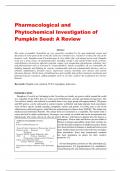Pharmacological and
Phytochemical Investigation of
Pumpkin Seed: A Review
Abstract
The seeds of pumpkin (Cucurbita sp.) are generally considered to be agro-industrial wastes and
discarded. In some parts of the world, the seeds are consumed raw, roasted or cooked, but only at the
domestic scale. Pumpkin seeds (Cucurbita pepo L.) are edible, flat, oval-shaped green seeds. Pumpkin
seeds are a great source of unsaturated fats, including omega-3 and omega-6 fatty acids, proteins,
carbohydrates, electrolytes, minerals (calcium, copper, iron, magnesium, phosphorous, selenium, zinc)
and phytonutrients such as Carotene-b, Cryptoxanthin-b, Lutein–zeaxanthin, all are responsible for
building immunity and fighting for various communicable and non-communicable diseases, such as
arthritis, inflammation, prostate cancer, depression, anxiety, insomnia, liver disease and various
infectious diseases. On the basis of traditional use and scientific data of their chemical constituents and
pharmacological evaluation, adding pumpkin seeds in our diet could be the prophylaxis for chronic
diseases.
Keywords: Pumpkin seed, nutrition, TUFA, tryptophan, depression
INTRODUCTION
Pumpkins (Cucurbit sp.) belonging to the Cucurbitaceae family are grown widely around the world
as a vegetable. In the USA, they are vastly used for Halloween carvings and thanks giving feasts. The
Curcurbiteae family, also referred as cucurbits form a very large group with approximately 130 genera
and 800 species, can be cultivated in warmer regions worldwide and make popular food crop plants;
some of these species include squashes, pumpkins, melons and gourds. Cucurbita pepo is one of the
oldest known cultivated species, with Mexican archaeological evidence from 7000 BC. This family has
medicinal and nutritional benefits. The unripe fruits are consumed as a vegetable. The mature fruit is
sweet and used to make confectionery, beverages, are roasted, or cooked and can be incorporated into
baked goods. The seeds, rich in oil, also are used in Mexico, with honey to prepare desserts known as
*Author for Correspondence Wadulkar
palanquetas. Flower buds and flowers are also edible in
R.D., Mexico to prepare quesadillas. Some fruit varieties are
E-mail: rwadulkar29@gmail.com used for decorative purposes in Halloween party. Plants
1
Research Scholar, Department of Pharmacology, School of have been pertinent to humans as medicinal sources and
Pharmacy, Swami Ramanand Teerth many modern drugs have been derived from secondary
Marathwada plant metabolites. Since time immemorial, mankind
University, SRTMU Nanded, Maharashtra, India 2
HOD & Professor, Department of
has been dependent on plants for their curative
Pharmacology, Channabasweshwar Pharmacy properties [1].
College, Latur, Maharashtra, India 3
Assistant Professor, Department of
Pharmacology, Several therapeutic activities are like antioxidant [2],
Shivlingeshwar College of Pharmacy, Latur, Maharashtra, hepatoprotective [3], hypolipidaemic [4], antidiabetic,
India
wound healing [5], anti-inflammatory [6], antibacterial
, Received Date: January 01, 2021 Accepted
[7], suppressing stimulated mononuclear cells [8],
Date: April 04, 2021 antihypertensive [9], antiarthritis [10], antidepressant
Published Date: May 03, 2021 [11] etc.
Traditional Uses of Pumpkin Seeds
Citation: Wadulkar R.D., Bhusnure O.G., Ladde S.S.
Pharmacological and Phytochemical Investigation of Ethnopharmacological studies show that Cucurbita
Pumpkin Seed: A Review. Research & Reviews: A Journal pepo is used worldwide for the treatment of various
of Pharmacognosy. 2021; 8(1): 25–32p. diseases such as a anti-inflammatory, antiviral,
analgesic urinary disorders, anti-ulcer, antidiabetic and
antioxidant [4, 5]. Traditionally, in Ayurvedic systems and in Chinese system, the different parts of
pumpkin are used for the treatment of various chronic diseases.
As per the reported traditional and scientific data, pumpkin exhibits important physiological and
pharmacological properties such as in wound healing, tumor growth inhibition, hypoglycaemic and
immunomodulation effects. The seeds are used as vermifuge, antihypertensive, to treat problem of
urinary treatment, as a prophylaxis for kidney stones, alleviates prostate diseases and in different skin
infections.
Phytochemical Constituents of Pumpkin Seeds
The herbal plant constitutes of different phytoconstituents that show therapeutic effects against
various diseases. The researchers reported significant potential of herbal drugs employed in various
traditional, complementary and alternative systems for treating diseases. The pharmacological and
phytochemical activities of several medicinal plants have been scientifically documented.
Pumpkin is one of the well-known edible plants and has substantial medicinal properties due to the
presence of unique natural edible substances. It contains several phytoconstituents belonging to the
categories of alkaloids, flavonoids, and palmitic, oleic and linoleic acids. These pharmacological effects
have been increasingly correlated with their nutritional and phytochemical composition. Among those
chemical constituents, carotenoids, tocopherols, phenols, terpenoids, saponins, sterols, fatty acids, and
functional carbohydrates and polysaccharides are those occurring in higher abundance. However, more
recently, a huge interest in a class of triterpenoids and cucurbitacins has been stated, given its renowned
biological attributes [11].
Nutritional Composition of Pumpkin Seeds
Pumpkin seeds are a great source of not only nutrients but also various micronutrients and minerals
like zinc, phosphorus, magnesium, potassium and selenium responsible for fighting diseases and acts
as a weapon for fighting diseases such as arthritis, inflammation, prostate cancer etc. Generally,
pumpkin seeds are considered as a waste, but they can play an important role in food by their nutritional
aspects.
They were generally regarded as a waste but now they can play an important role in food by
nutritional aspects. Pumpkin seeds’ nutritional chart and their values are as shown in Table 1 [12].
Pumpkin seeds are a rich source of tryptophan, which is essential amino acid and also acts as
precursor for various neurotransmitters which play an important role in normal physiology of the brain.
The kernels of pumpkin seeds have been utilized as flavor enhancers in soups, and used in cooking and
baking as a nutrient supplement and a functional agent.




